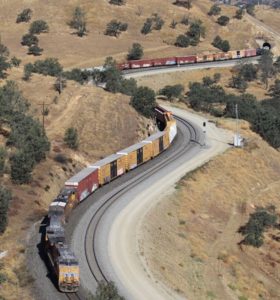
Shippers and railcar leasing companies have expressed concern over the retirement cliff coming in the next few years, in which nearly half the fleet of 102,000 cars will hit retirement age or be sidelined by rising maintenance costs. Leasing companies say that at current default rates, it makes no financial sense to build new cars.
But Paddy O’Neill, assistant vice president of fleet planning and optimization at Norfolk Southern, says those fears are overblown. “The pending boxcar shortage is just plain fake news,” he says.
Although retirements will continue to outpace the building of new cars, O’Neill says railroads won’t need as many. New cars carry more freight and will make more revenue trips per year as part of the North American boxcar pool and due to higher railroad velocity, he contends.
And O’Neill’s analysis assumes that nearly all of the 12,000 boxcars that have been stored since at least 2018 are not needed and therefore don’t need to be replaced. “If a boxcar couldn’t catch a load in 2018, it’s not going to catch a load,” O’Neill says.
The retirement of these cars, he notes, will have no impact on the utilization of the remaining fleet. Most of the stored cars — and those about to hit mandatory retirement age — are “standard” 70-ton, 50-foot boxcars.
Railroads can handle more tonnage with a smaller fleet because newer cars are 100-ton, 60-foot Plate F cars, O’Neill points out. The newer cars have a 30% higher capacity than their older 50-foot counterparts, he says.
And that means fewer new cars will be required to replace those being retired from service.
O’Neill says only 20,000 cars will be needed to replace the 34,300 that will age out of the fleet by 2030. At that rate, the industry will need 2,500 new cars per year, which is below the recent build rates, O’Neill says.
TTX has a more pessimistic view, and forecasts a 50,900-car drop in the boxcar fleet by 2030. But if the recent average build rate continues in coming years, there’s only a slight overall capacity deficit by the end of the decade, O’Neill says.
“No matter how you slice and dice the data, making some reasonable assumptions you can see there’s plenty of capacity in the future in boxcars,” O’Neill says. “What we really need to do is increase demand to meet supply. So it’s pretty hard to imagine a scenario where we’re going to have trouble.”
Half of all boxcar volume has disappeared since 2000, according to data from the Association of American Railroads.
Some shippers have raised concerns about the shift to 60-foot high-capacity boxcars, including loading dock spacing built around 50-foot cars, the inability to take full advantage of the extra capacity when bulky cargo can’t be stacked inside the boxcar, and clearance restrictions in some areas.
“Norfolk Southern has helped shippers resolve all of these types of concerns, including working with one state department of transportation to raise a highway overpass so a Plate F boxcar would fit underneath,” O’Neill says.
The more dire forecasts for boxcar fleet retirements and replacements don’t account for improved railroad performance, O’Neill points out.
O’Neill showed a chart that indexed the number of loads boxcars handled on Norfolk Southern indexed to 2015. NS struggled in 2018, then car productivity surged when it shifted to a Precision Scheduled Railroading operating model.
“If you assumed that our cars were only getting 11 trips per year like the North American boxcar pool average, with this bump in velocity we’d be getting 14,” O’Neill says.
“Car velocity really matters,” O’Neill says.
O’Neill spoke at the virtual conference of the North East Association of Rail Shippers.













